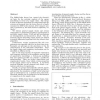Free Online Productivity Tools
i2Speak
i2Symbol
i2OCR
iTex2Img
iWeb2Print
iWeb2Shot
i2Type
iPdf2Split
iPdf2Merge
i2Bopomofo
i2Arabic
i2Style
i2Image
i2PDF
iLatex2Rtf
Sci2ools
108
click to vote
ER
2007
Springer
2007
Springer
Selfish-brain Theory: Challenges in the Top-down Analysis of Metabolic Supply Chains
The Selfish-brain theory has created the theoretical basis for the systemic analysis of the energy metabolism in terms of a supply chain. The energy in form of glucose equivalents is transported from the exterior environment into the brain where it is finally consumed as ATP in the neurons. The transport process is governed by the brain itself as regulatory authority. We discuss general supply chains and certain components to understand regulatory mechanisms in metabolic supply chains. Push and pull mechanisms are distinguished and discussed in detail. The dynamical systems describing supply chains are related to partial differential equations and they inherit their properties. Furthermore, certain components like side compartments are regarded which act as short-time store. Examples are glycogen in the glycolysis or the fat compartment in the individual metabolism. Similar supply chains and regulatory mechanisms can be identified at different levels. Due to the large amount of regula...
| Added | 14 Aug 2010 |
| Updated | 14 Aug 2010 |
| Type | Conference |
| Year | 2007 |
| Where | ER |
| Authors | Dirk Langemann |
Comments (0)

